News
Jan 2019 | Peng's paper publishedHuo Peng's paper is finally published in Phys.Lett.B. The published version has a nice appendix to discuss the impact of flow decorrelation on subevent cumulants. |
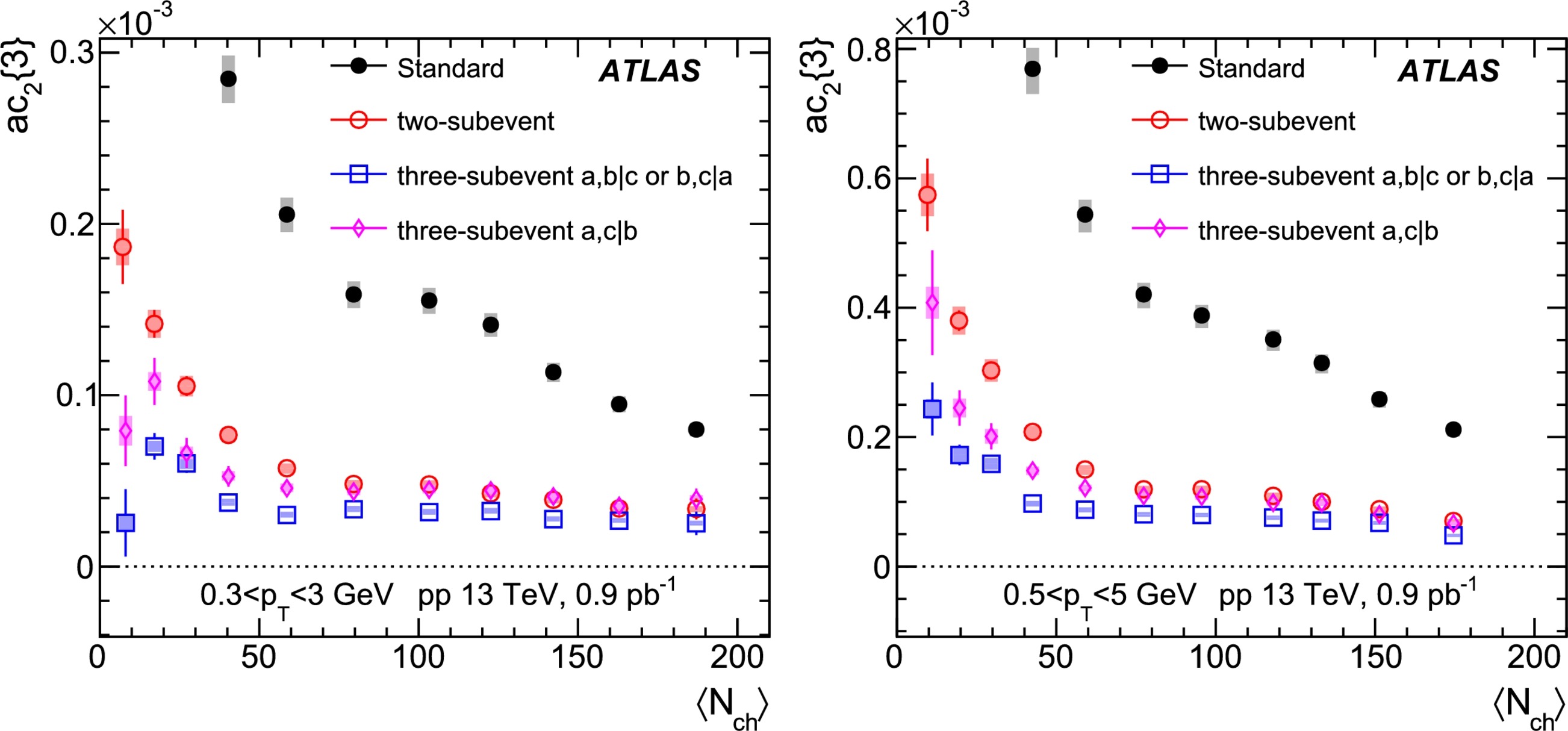 |
Dec 2018 | Niseem graduatedNiseem Magdy successfully defended his Ph.D. Thesis on "Beam Energy and Collision System Dependence of Anisotropic Flow and Its Fluctuations in STAR"He has already got an Post Doc offer from University of Illinois at Chicago working with Prof. Olga vdokimov. |
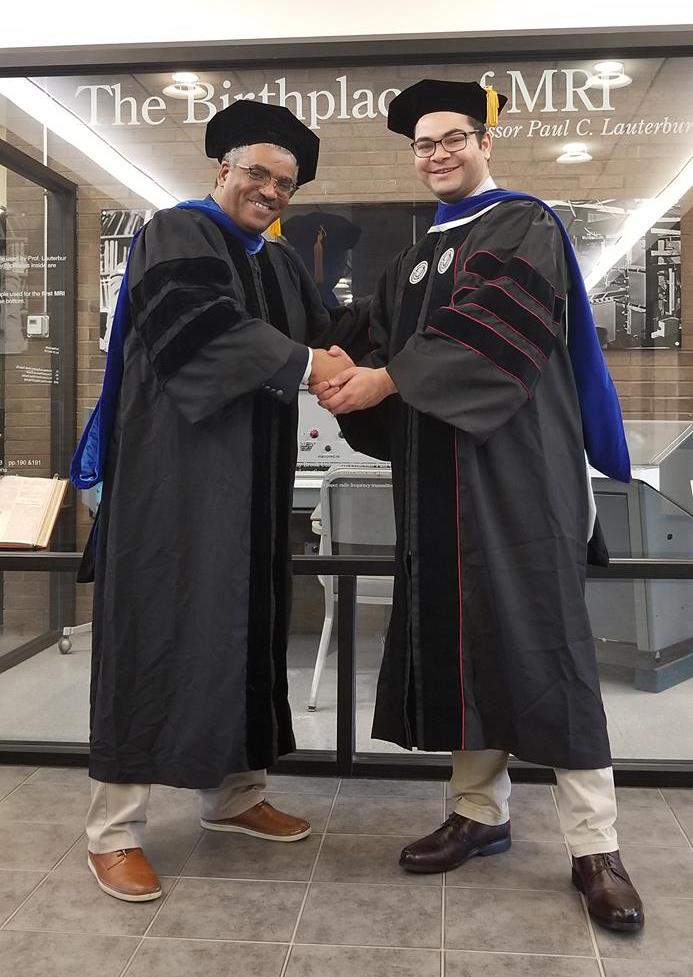 |
Aug 2018 | Peng passed Ph.D. defensePeng Huo successfully defended his Ph.D. Thesis on "Measurements of event-by-event fluctuation of anisotropic flow in pp, p+Pb and Pb+Pb collisions with the ATLAS detector", congratulations!Peng is now a data analyst in JP Morgan. |
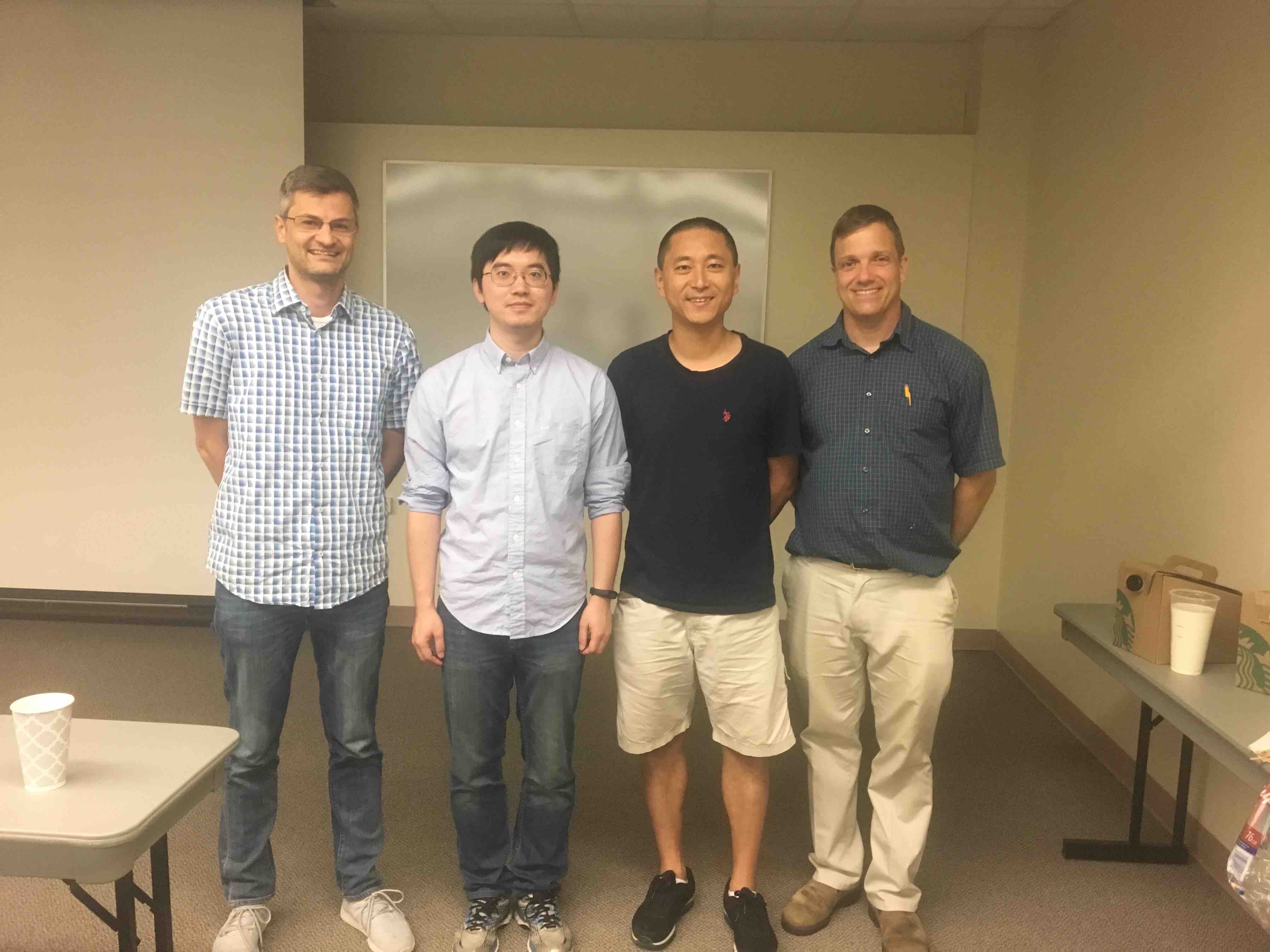 |
May 2018 | Maowu passed Ph.D. defensePlease join us in congratulating Maowu Nie who successfully defended his PhD thesis at SINAP on May 24, 2018. His thesis title is: "Investigation of Anisotropic Flow in Relativistic Heavy-ion Collisions".As you know, Maowu has been with us for two years as a visiting student and he went back to SINAP at the end of 2017. He has accepted a Post Doc position in ShanDong University with Prof Li Yi. |
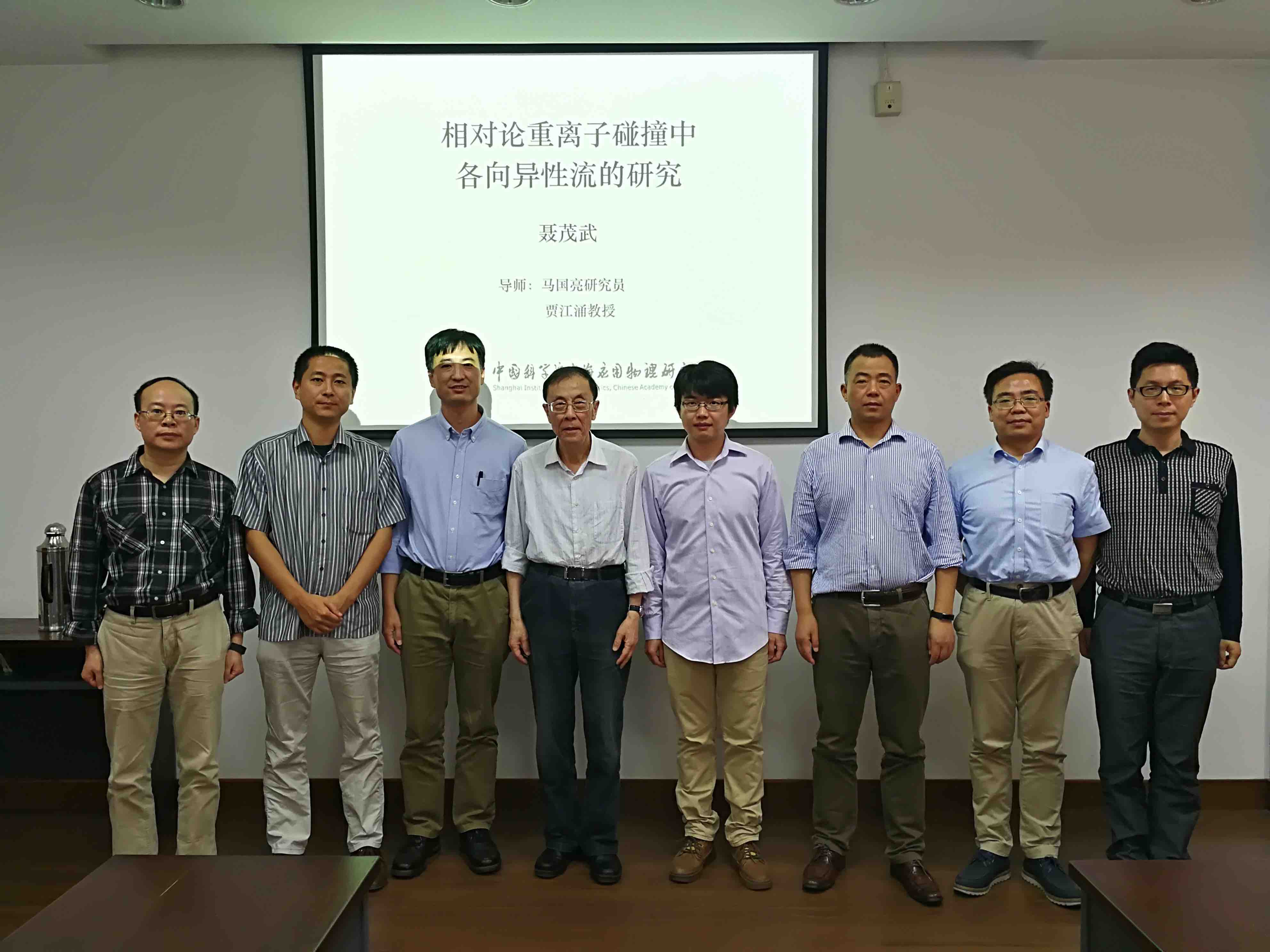 |
May 2018 | Quark MatterIn the Quark Matter 2018 conference in Venice, Italy.Mingliang Zhou (ATLAS), Niseem Magdy (STAR) and Shengli Huang (STAR) presented their results in the parallel session. Jiangyong Jia gave a student lecture. |
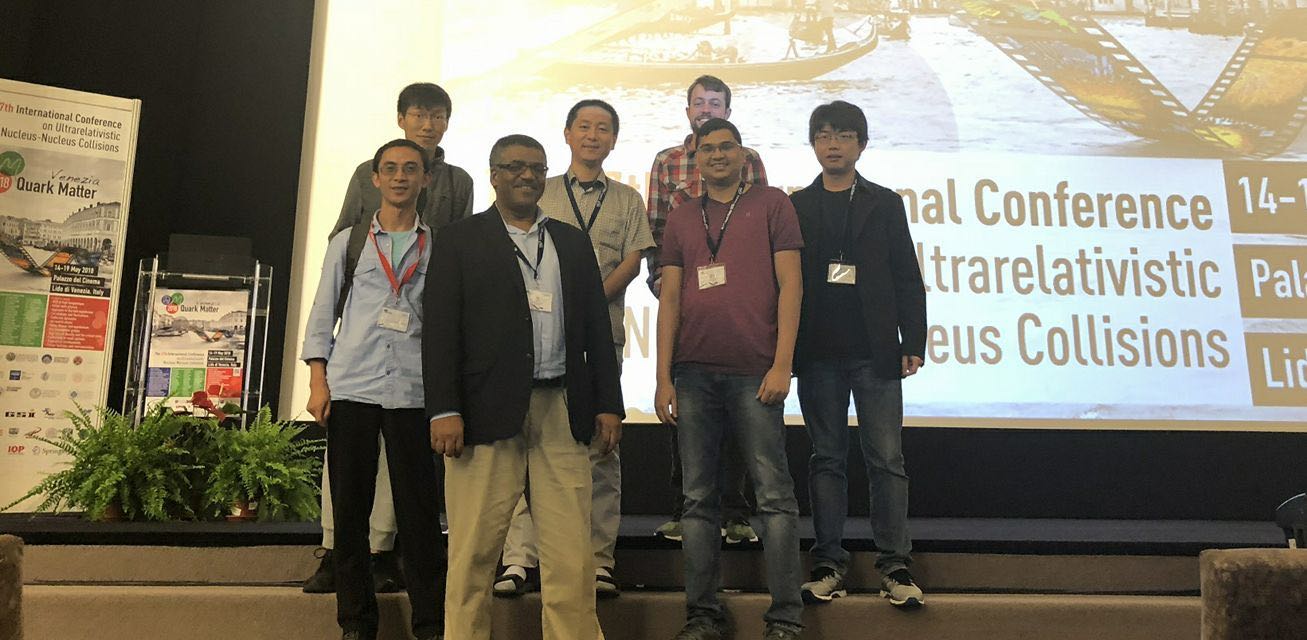 |
Mar 2018 | Paper publishedFinally published this paper. Have learned a lot about multiplicity fluctuations in the last few months. Hopefully this work clarifies a bit the meaning of centrality and the nature of it fluctuations.Work on this using ATLAS and STAR data is ongoing... |
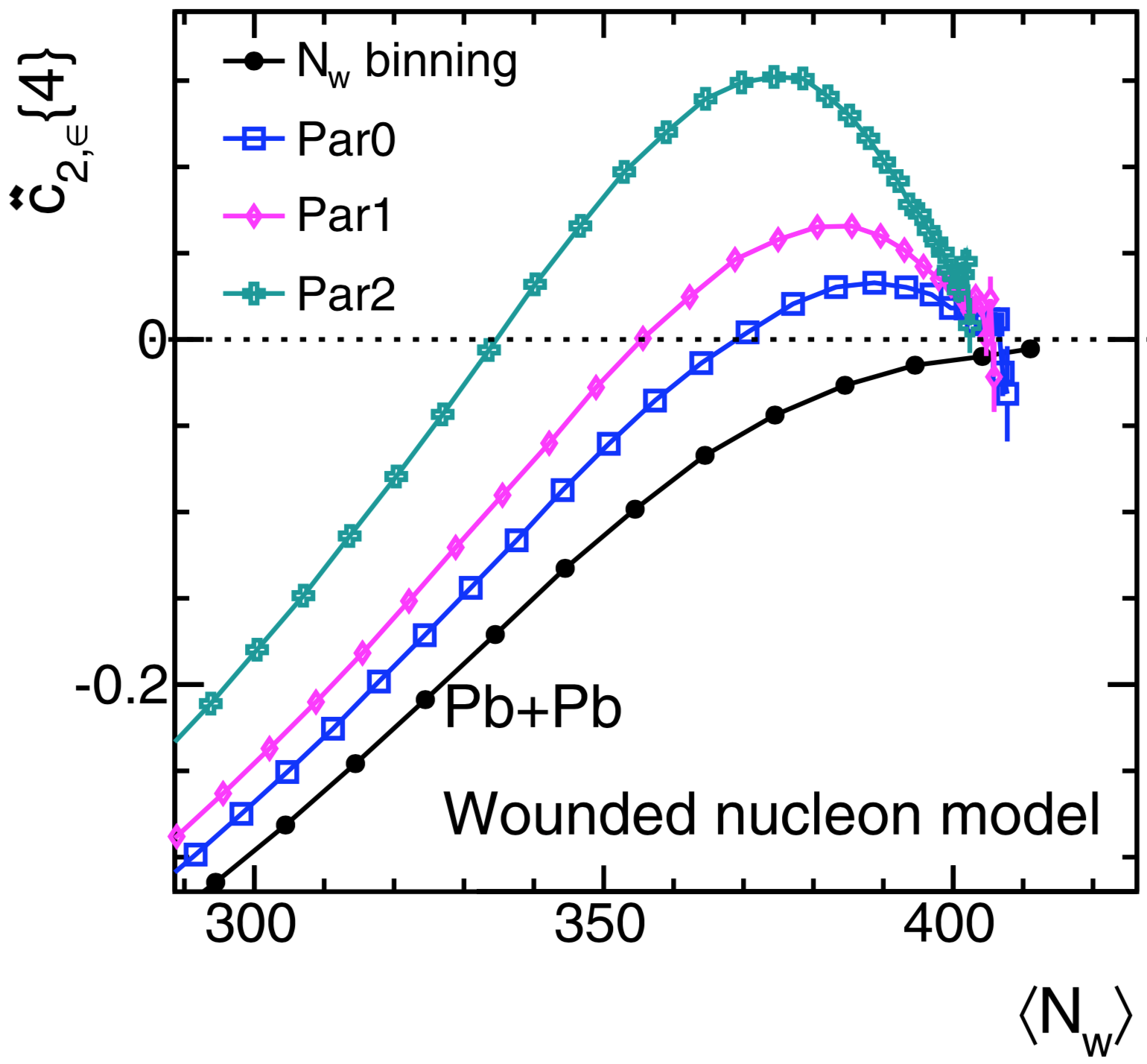 |
Feb 2018 | Peng's paper publishedFrankly, we are surprised that referee was giving us a lot of trouble for being creative in this paper. For example, they complained we invented new observables without theoretical predictions. But we are happy it is published.A good work by Peng Huo. |
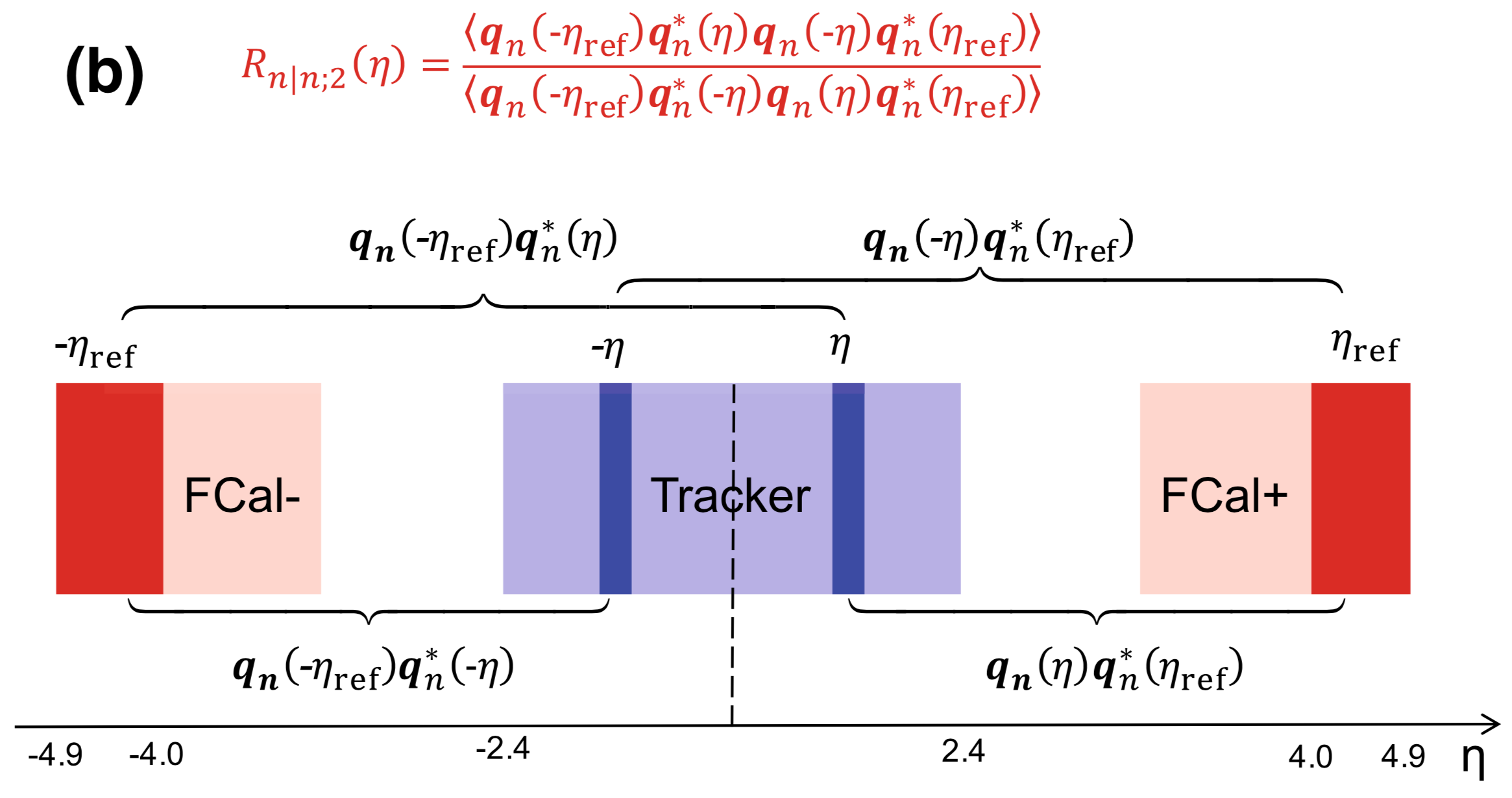 |
Feb 2018 | Mingliang's paper publishedMeasurement of long-range multi-particle azimuthal correlations with the subevent cumulant method in pp and p+Pb collisions with the ATLAS detector.Very proud of this paper by Mingliang Zhou. 15 citations already. |
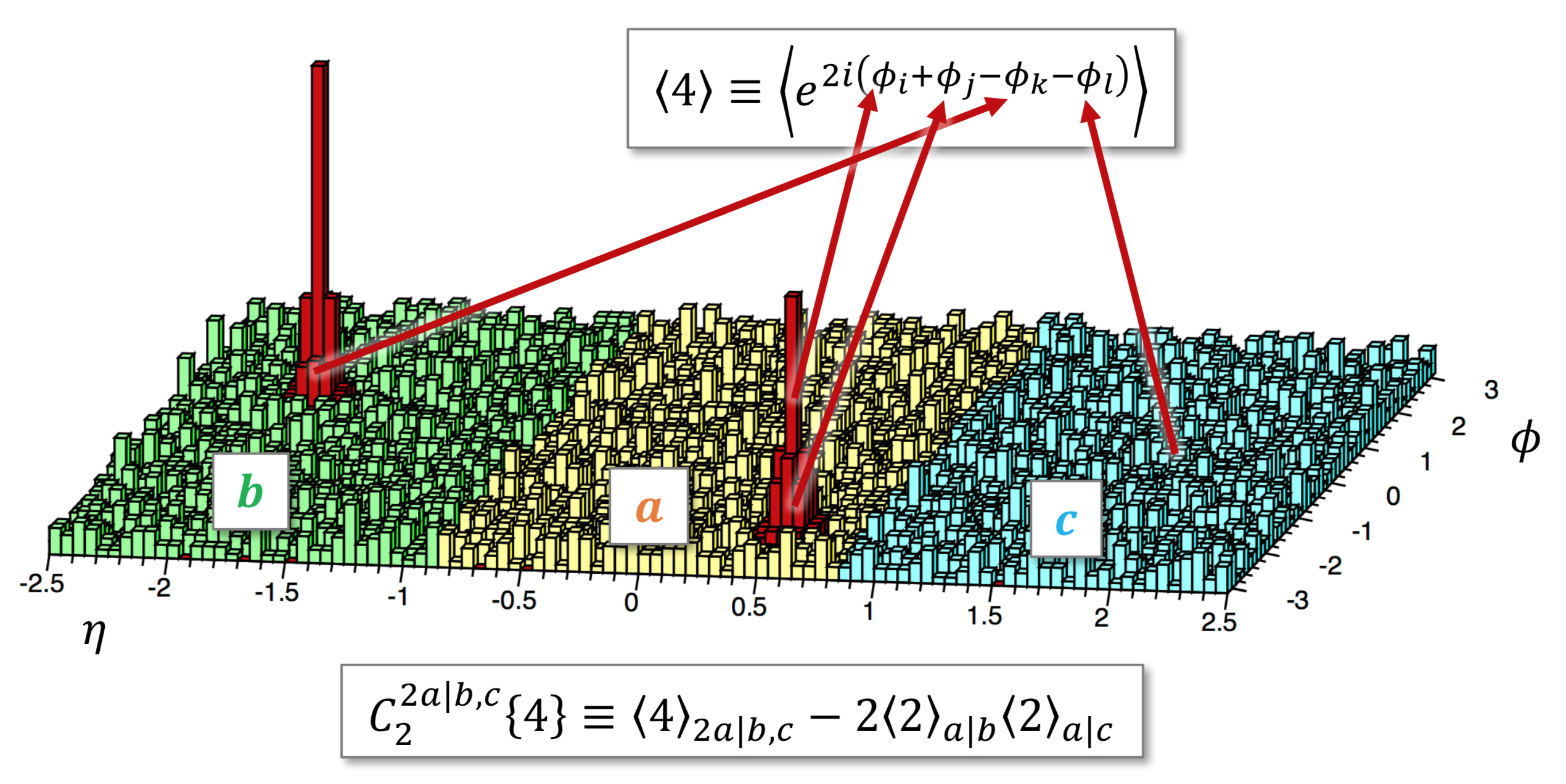 |
Sep 2017 | Initial StagesInitial Stages 2017 took place in Krakow, Poland.Our group has five talks given by Mingliang Zhou, Niseem Magdy, Roy Lacey, Maowu Nie and Jiangyong Jia. |
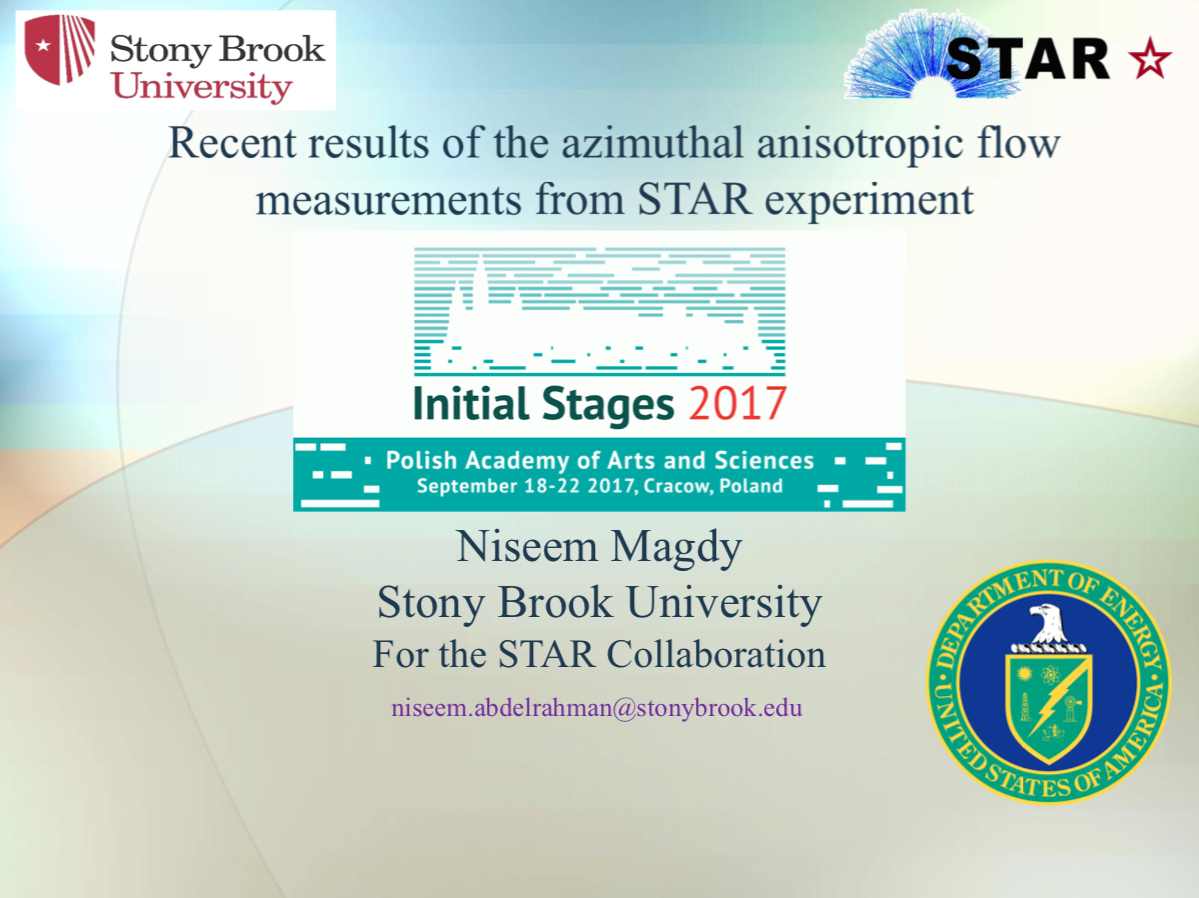 |
Aug 2017 | ATLAS highlightExploring the nature of the "ridge" in small systems. Our work is highlighted by ATLAS.This article is written to explain the value of this work (we had to remake some figures). |
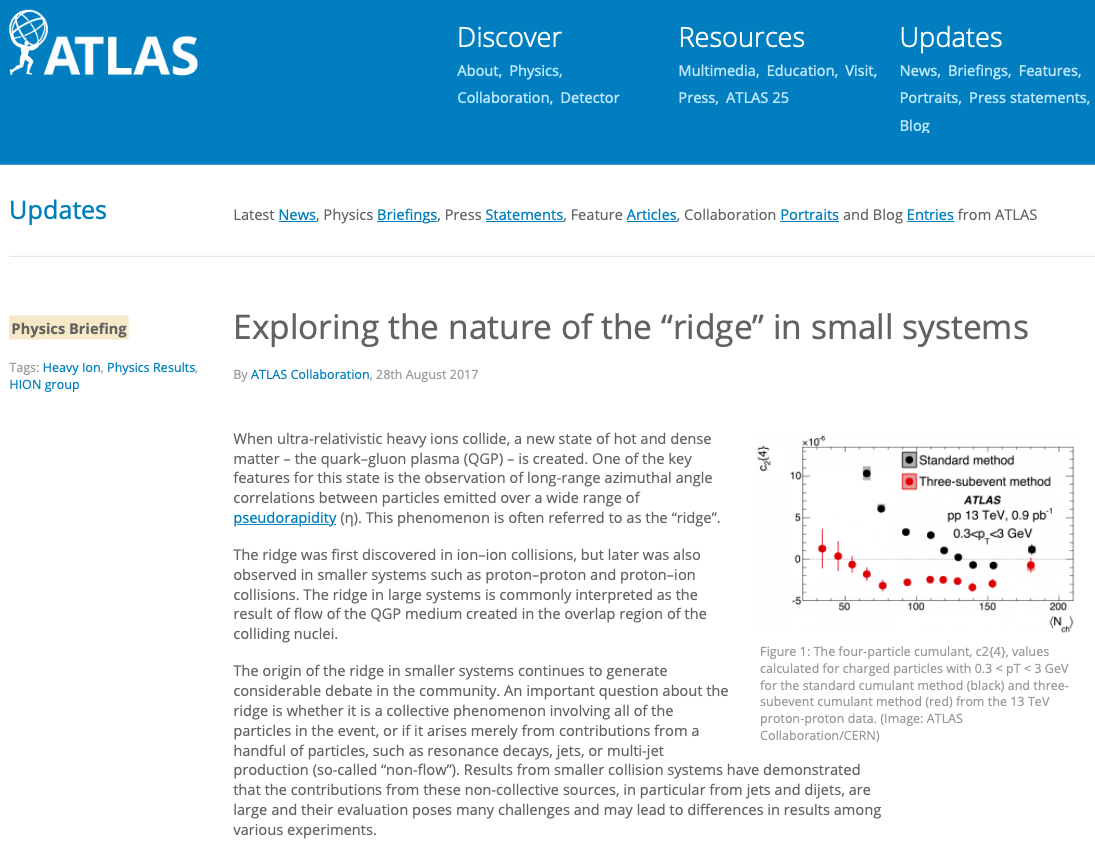 |
Feb 2017 | Quark MatterQuark Matter 2017 conference took place in Chicago in the cold winter this year.Mingliang Zhou presented his brand new results on multi-particle flow measurements used a brand new subevent technique that he has developed in the last year. Peng huo's poster on flow decorrelations was selected as one of the five flash talks. Jiangyong Jia gave a overview talk on the ATLAS results. |
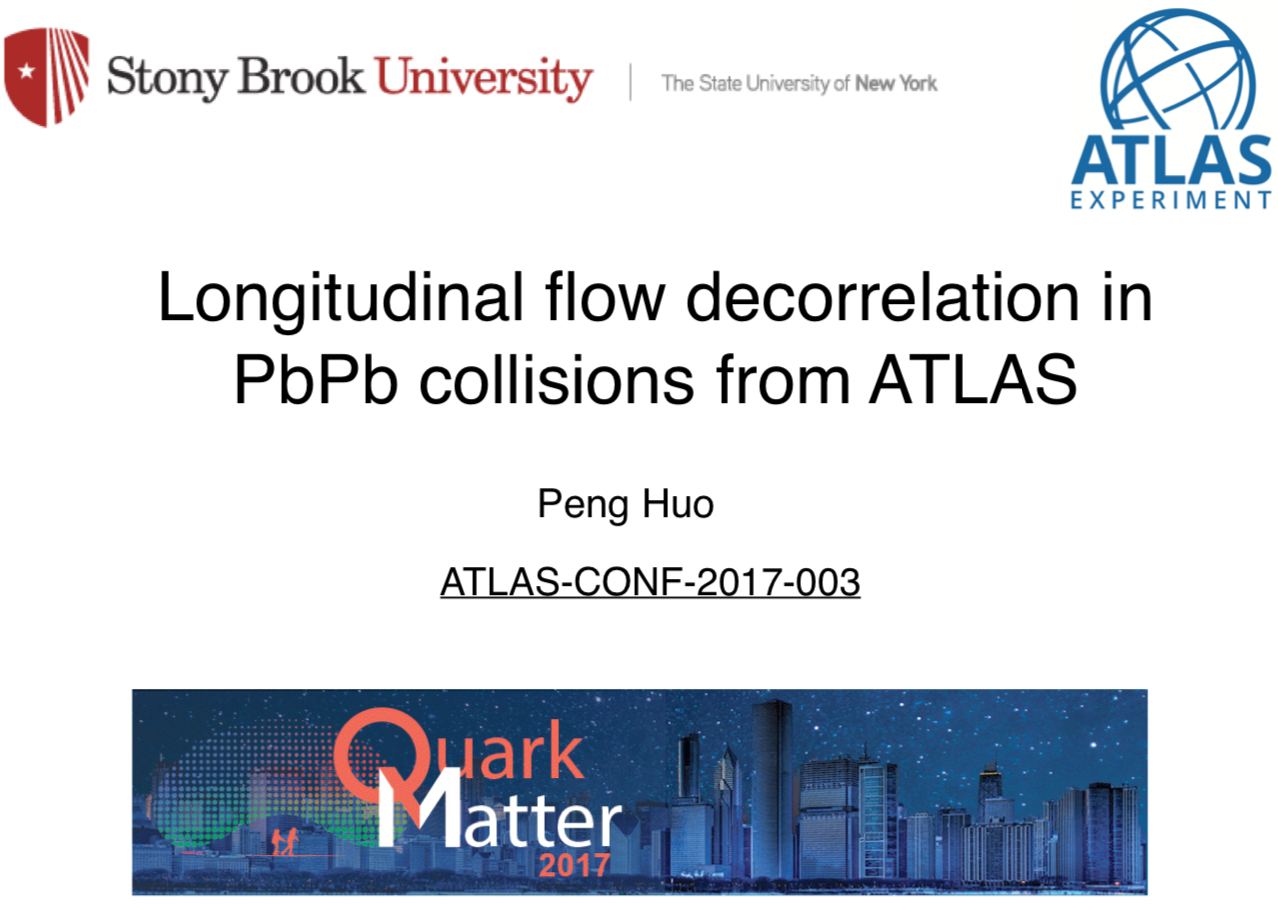 |
Aug 2016 | Sooraj graduatedSooraj Radhakrishnan successfully defended his Ph.D. thesis on "study of long-range azimuthal and longitudinal correlations in high energy nuclear collisions at the LHC using the ATLAS detector".He has already got a postdoc offer from LBNL working with Xin Dong on STAR. |
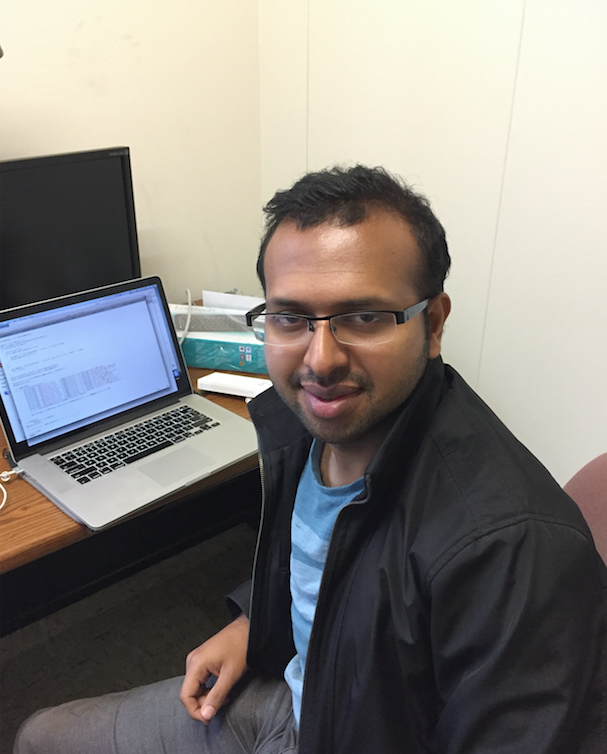 |
Jun 2016 | Paper publishedWe are happy it is finally out! This work is done by Sooraj and Mingliang.What else can you do with rapidity multiplicity fluctuation, ideas? |
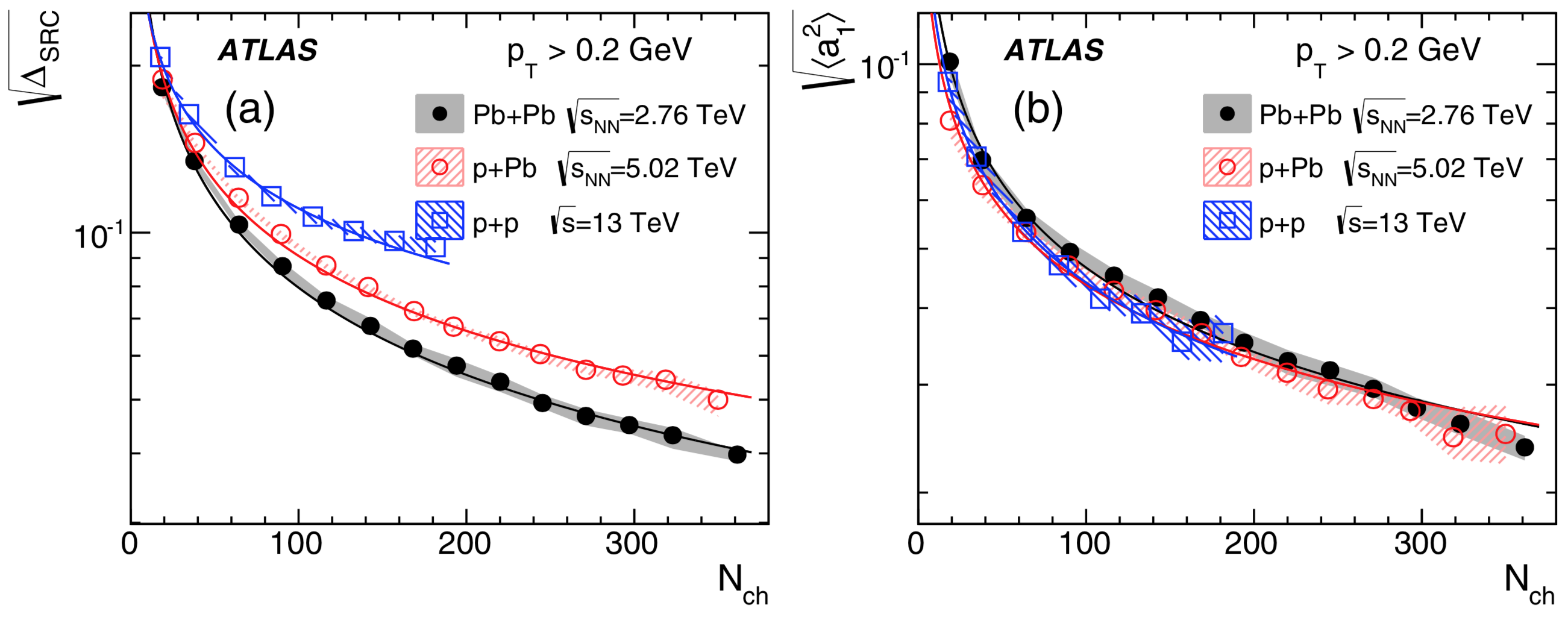 |
Jun 2016 | Initial StagesInitial Stages 2016 took place in Lisbon, Portugal on May 23rd to 27th 2016.This conference has become an important avenue for understanding the initial state geometry and final state correlations of heavy ion collisions. Our group has four talks given by Mingliang Zhou, Niseem Magdy, Roy Lacey and Jiangyong Jia. |
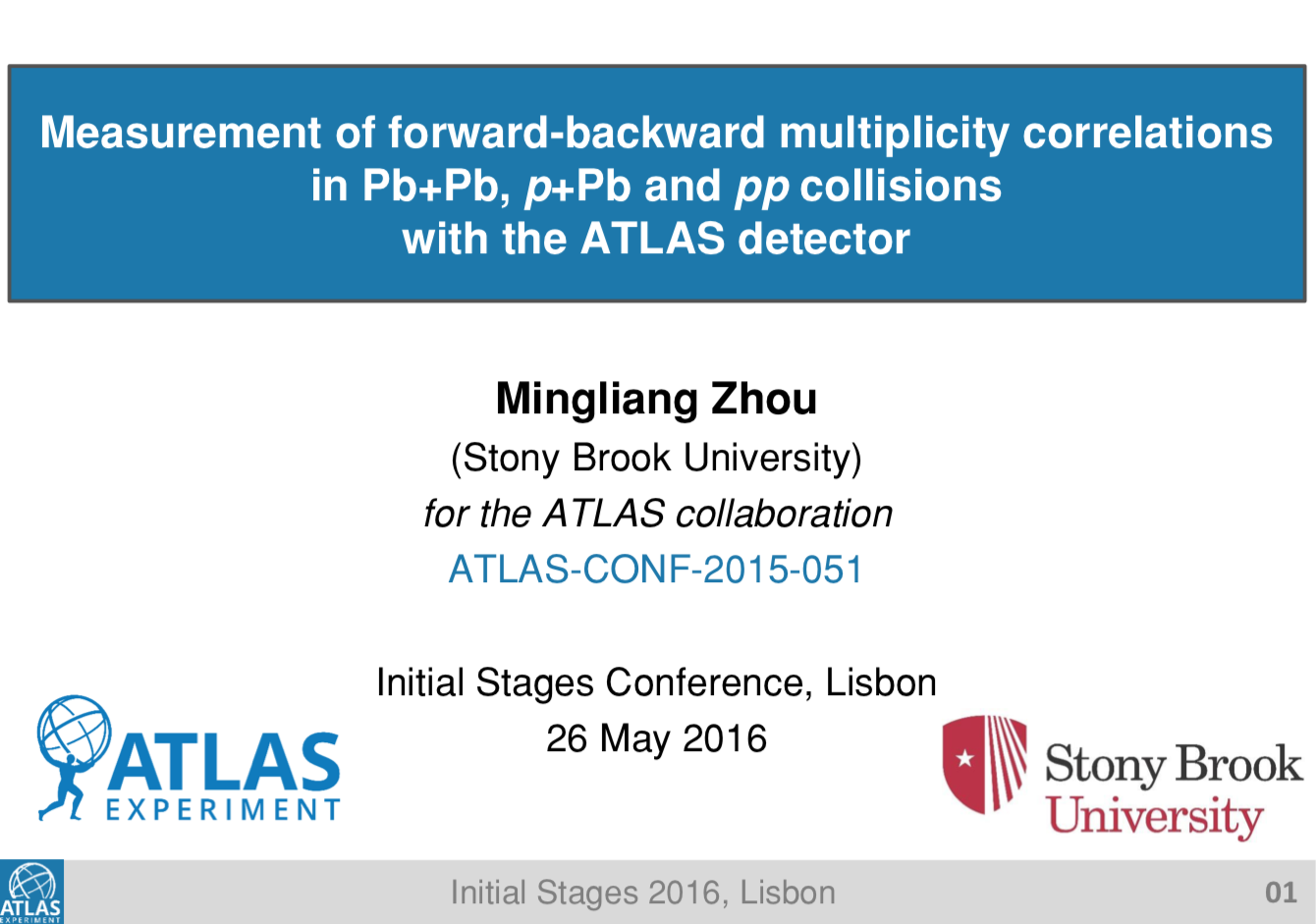 |
May 2016 | Thomas graduatedThomas Balestri successfully defended his Ph.D. thesis on "W boson production in ultra-relativistic heavy-ion collisions at the LHC".He is now a data scientist in private sector. |
 |
Oct 2015 | Quark MatterThe XXV edition of Quark Matter conference took place in the beautify city of Kobe, Japan. Our group has a strong showing in this conference with four parallel talks presented:Sooraj Radhakrishan, "Correlation between flow harmonics of different order in 2.76 TeV Pb+Pb Collisions from ATLAS". Mingliang Zhou, "Ridge and v2 in pp collisions from ATLAS". Thomas Balestri, "Electroweak boson production in Pb+Pb collisions at 2.76 TeV with the ATLAS detector". Jiangyong Jia, "Forward-backward multiplicity correlations in PbPb, pPb and pp collisions from ATLAS". Peng Huo, "Forward-backward multiplicity fluctuation and longitudinal harmonics in high-energy nuclear collisions". |
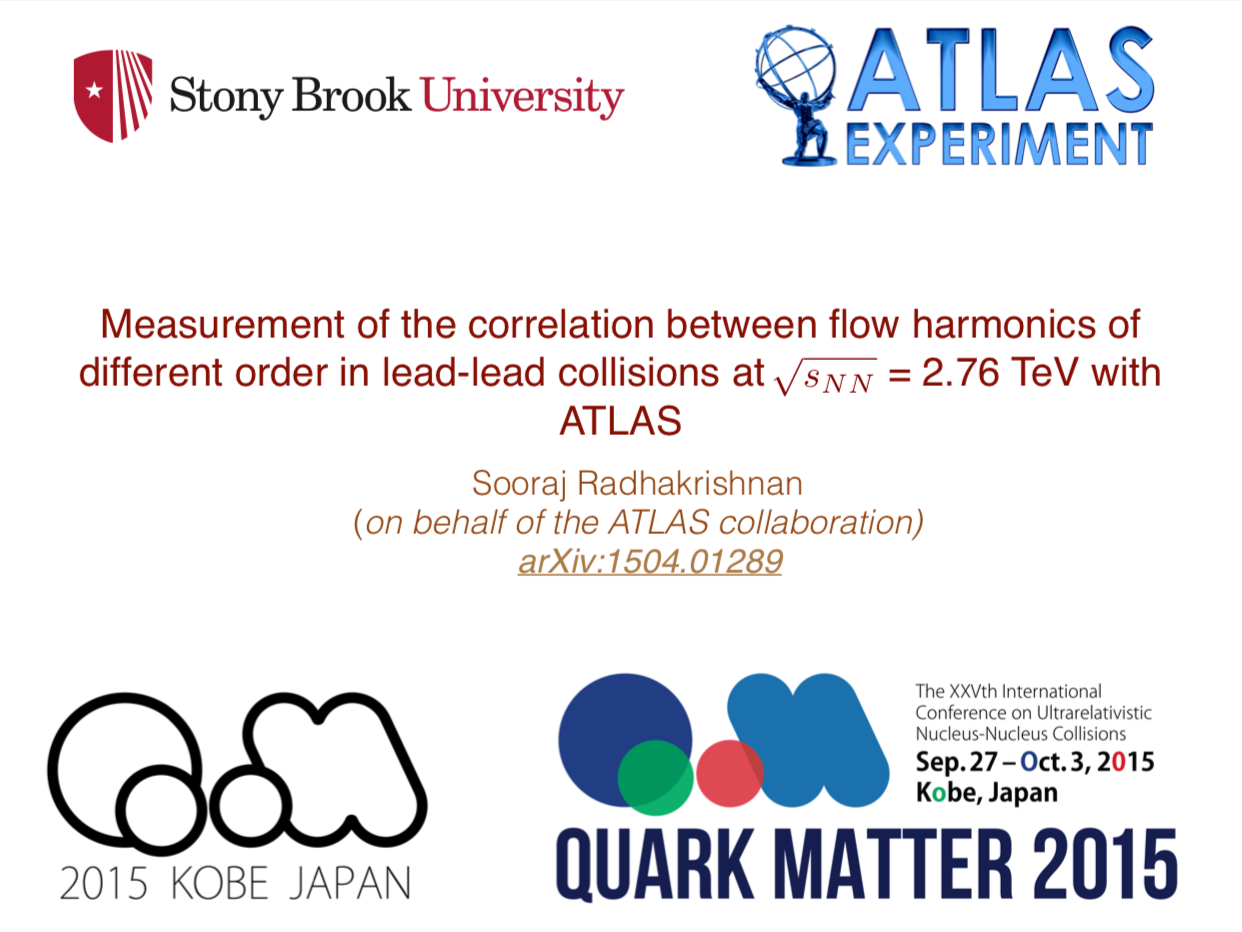 |
April 2015 | Soumya's paper publishedExcellent collaboration work with Soumya Mohaptra."Measurement of the correlation between flow harmonics of different order in lead-lead collisions at 2.76 TeV with the ATLAS detector". |
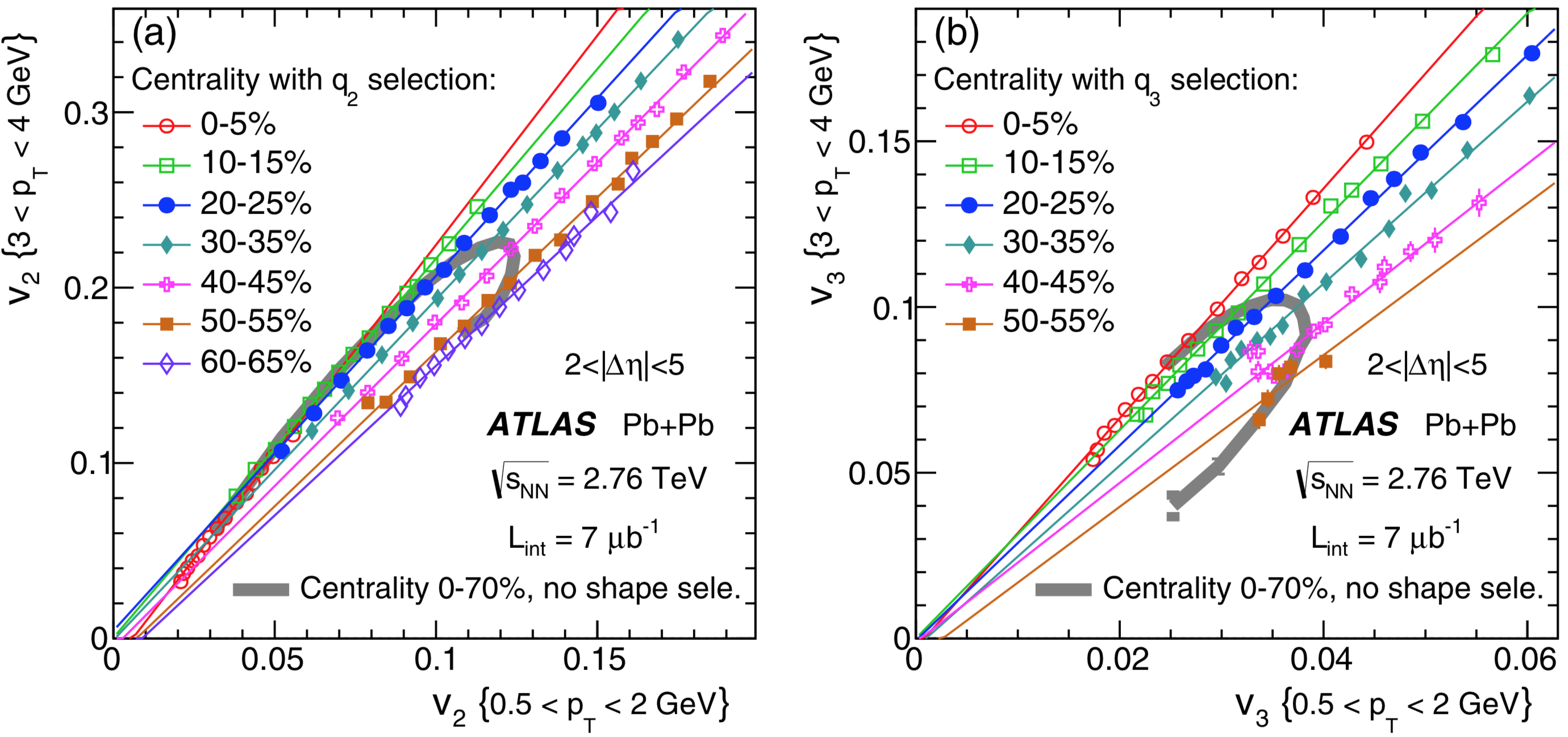 |
Group Photos

Dec 2018 | Jiangyong's daughter's sketch of group's new year party.

Oct 2018 | Heavy ion group celebrating Niseem's graduation!
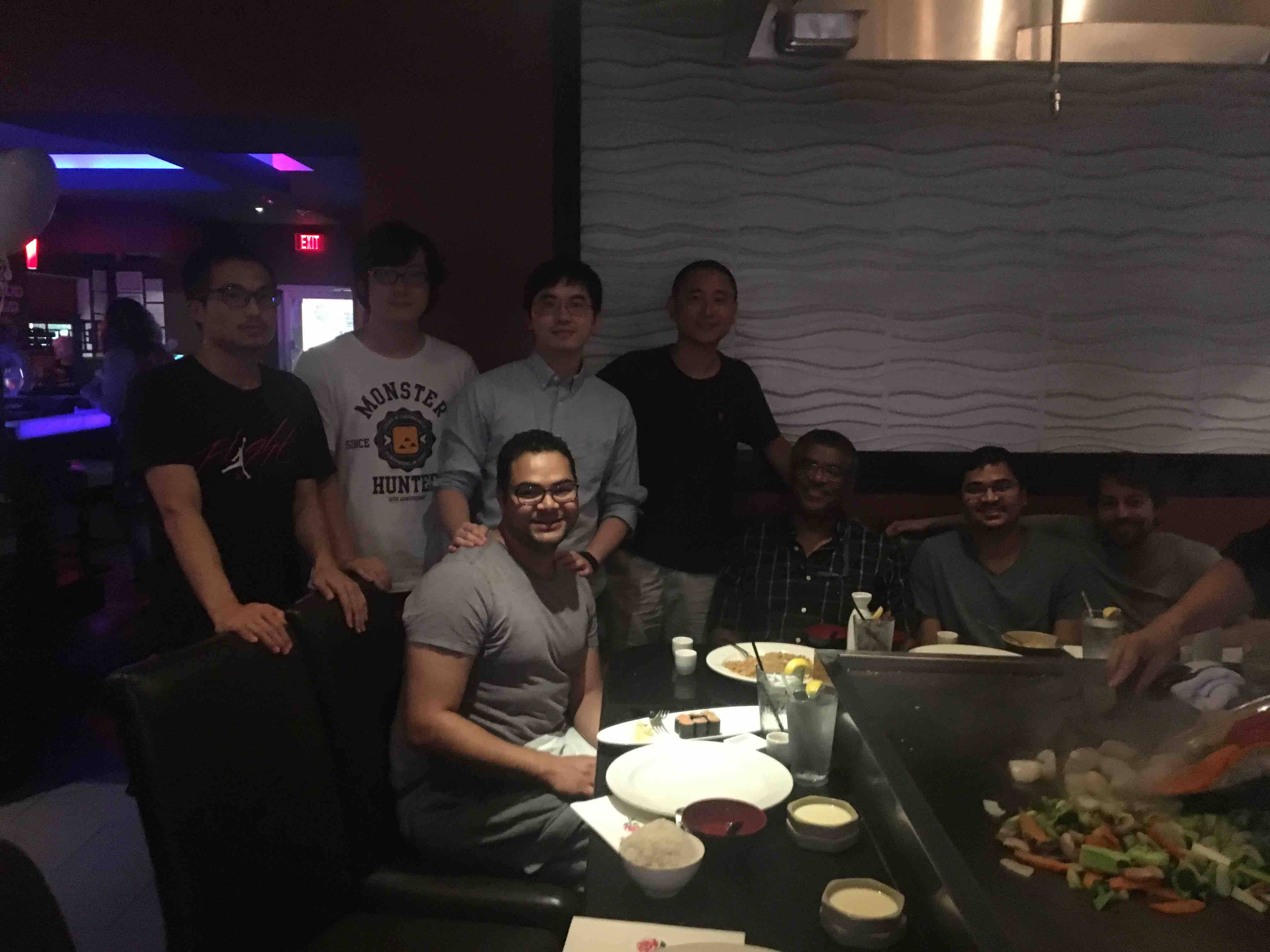
Aug 2018 | Heavy ion group celebrating Peng's graduation!
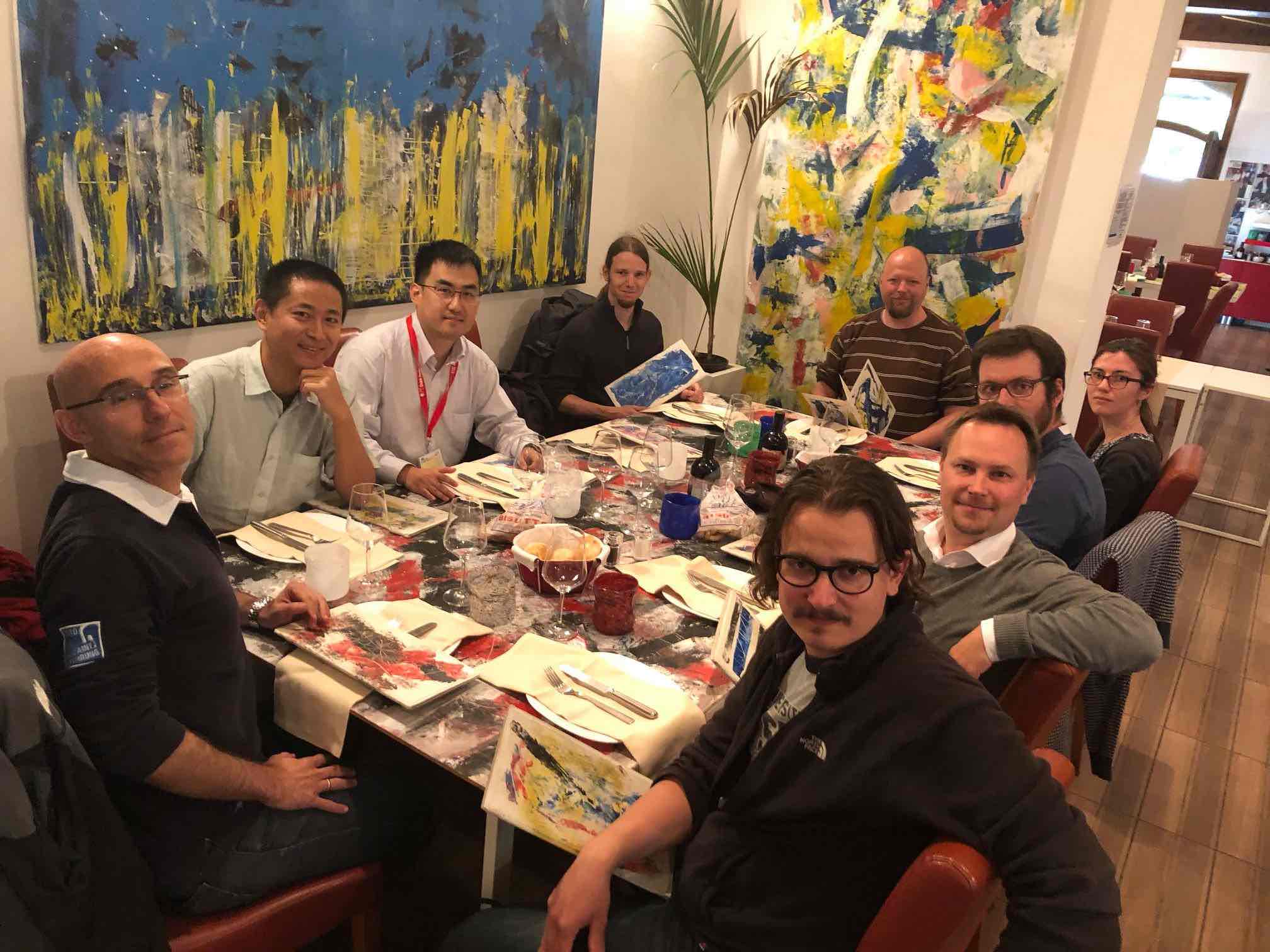
May 2018 | Jiangyong Jia attending Quark Matter 2018 small systemi white paper meeting.

May 2018 | Maowu Nie passed Ph.D. thesis defense. Congratulations!
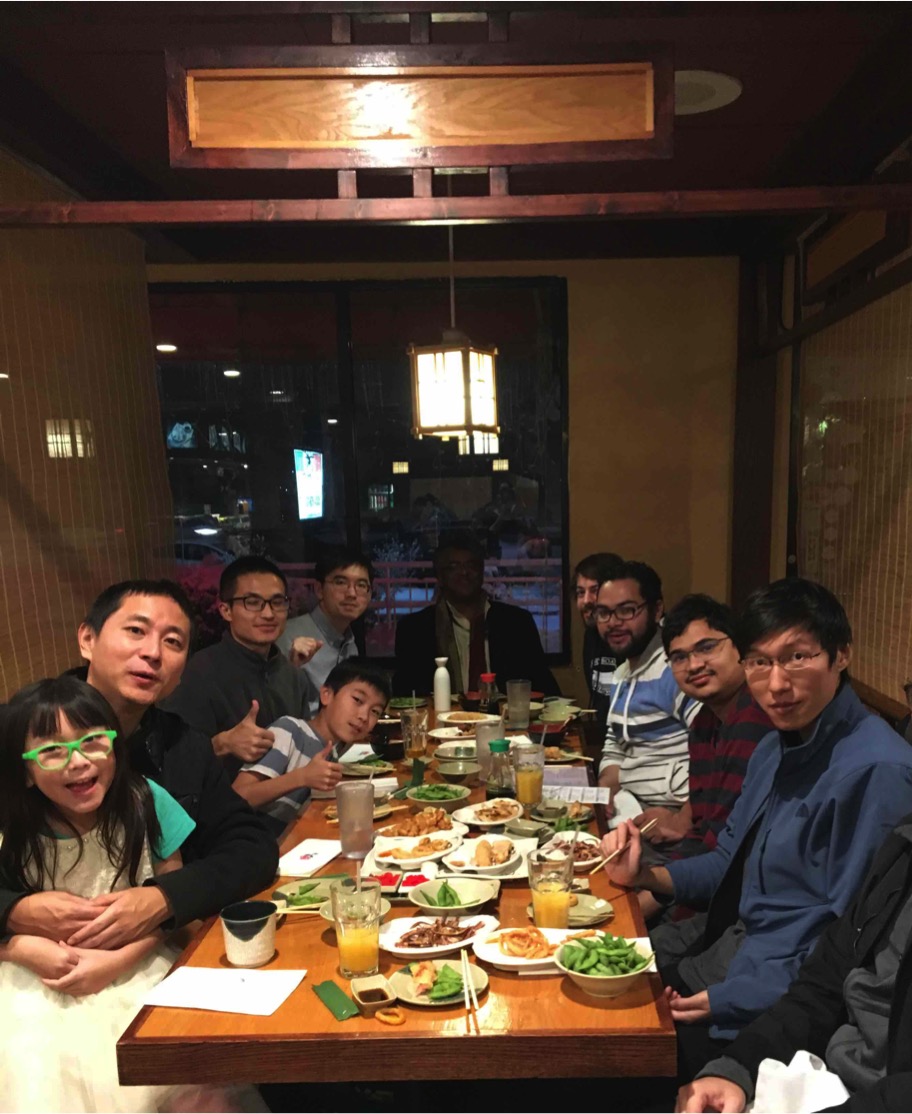
Dec 2017 | Merry Christmas! Heavy ion group party for new year!
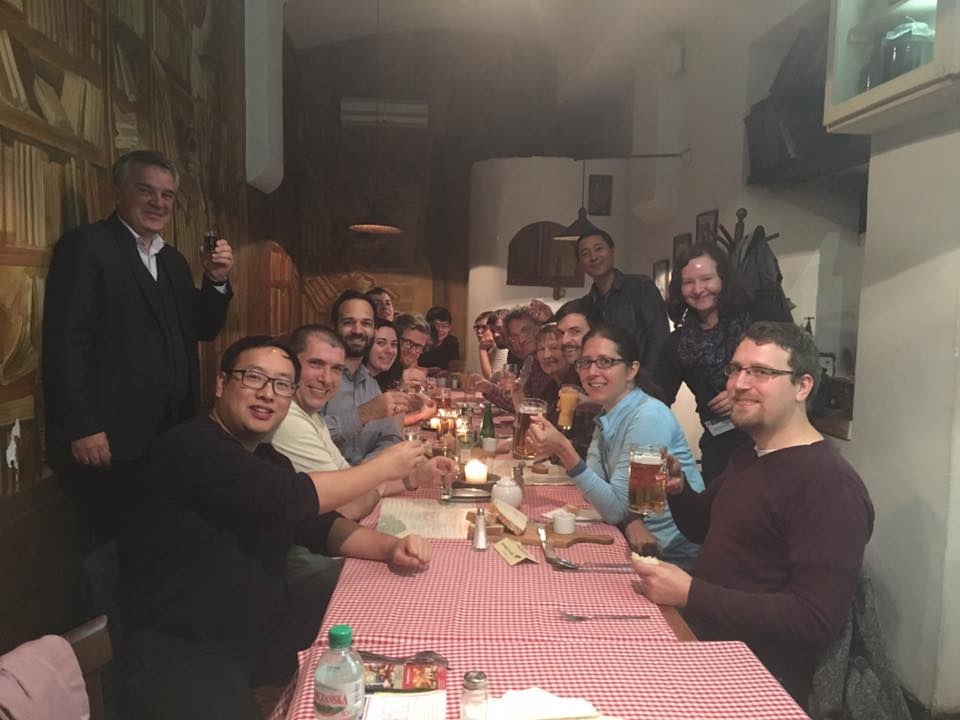
Sep 2017 | ATLAS collaboration at Initial Stage 2017, Krakow, Poland.
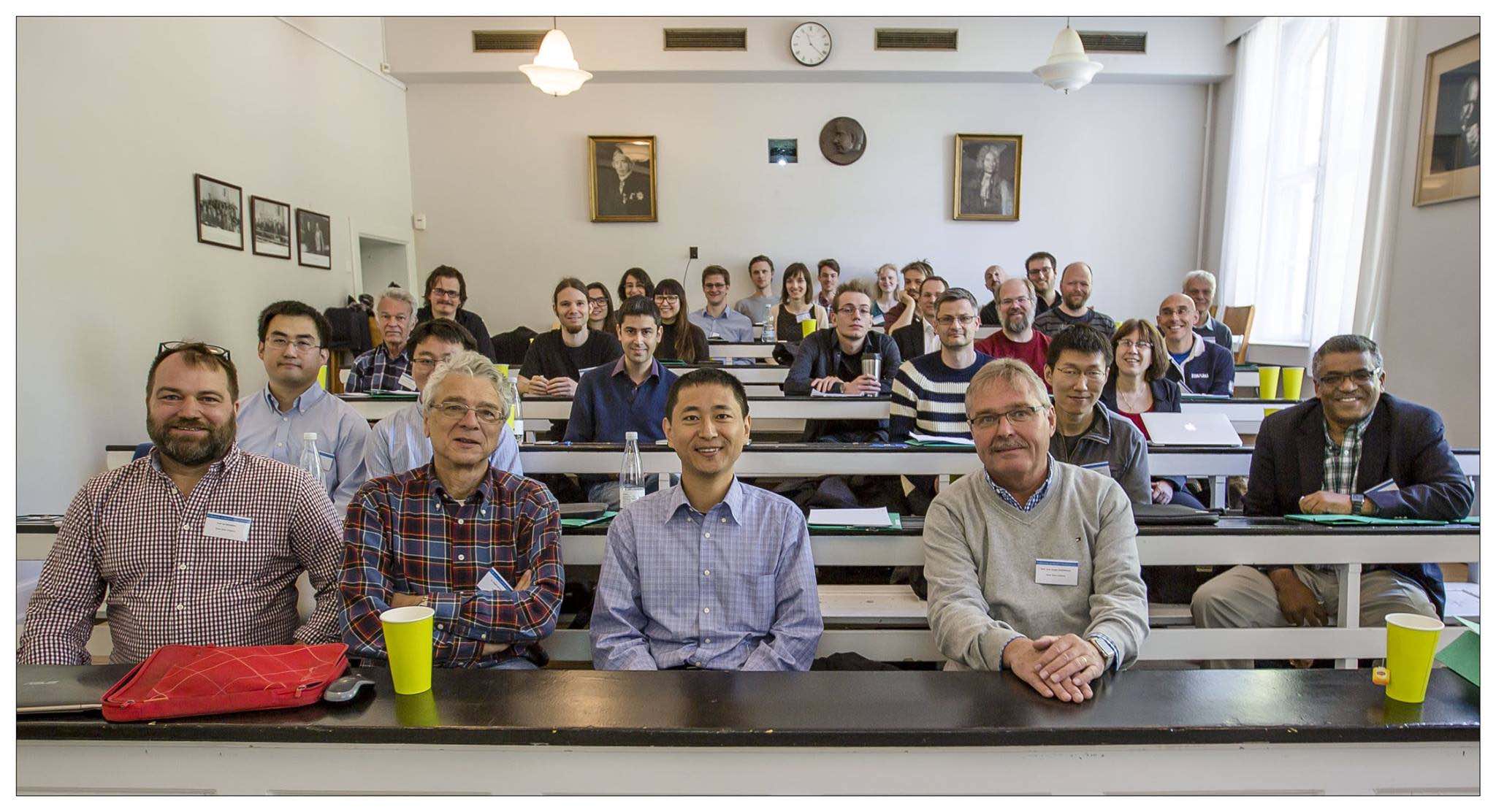
May 2017 | Jiangyong Jia and Mingliang Zhou attending Small System Workshop, Copenhagen, Denmark.
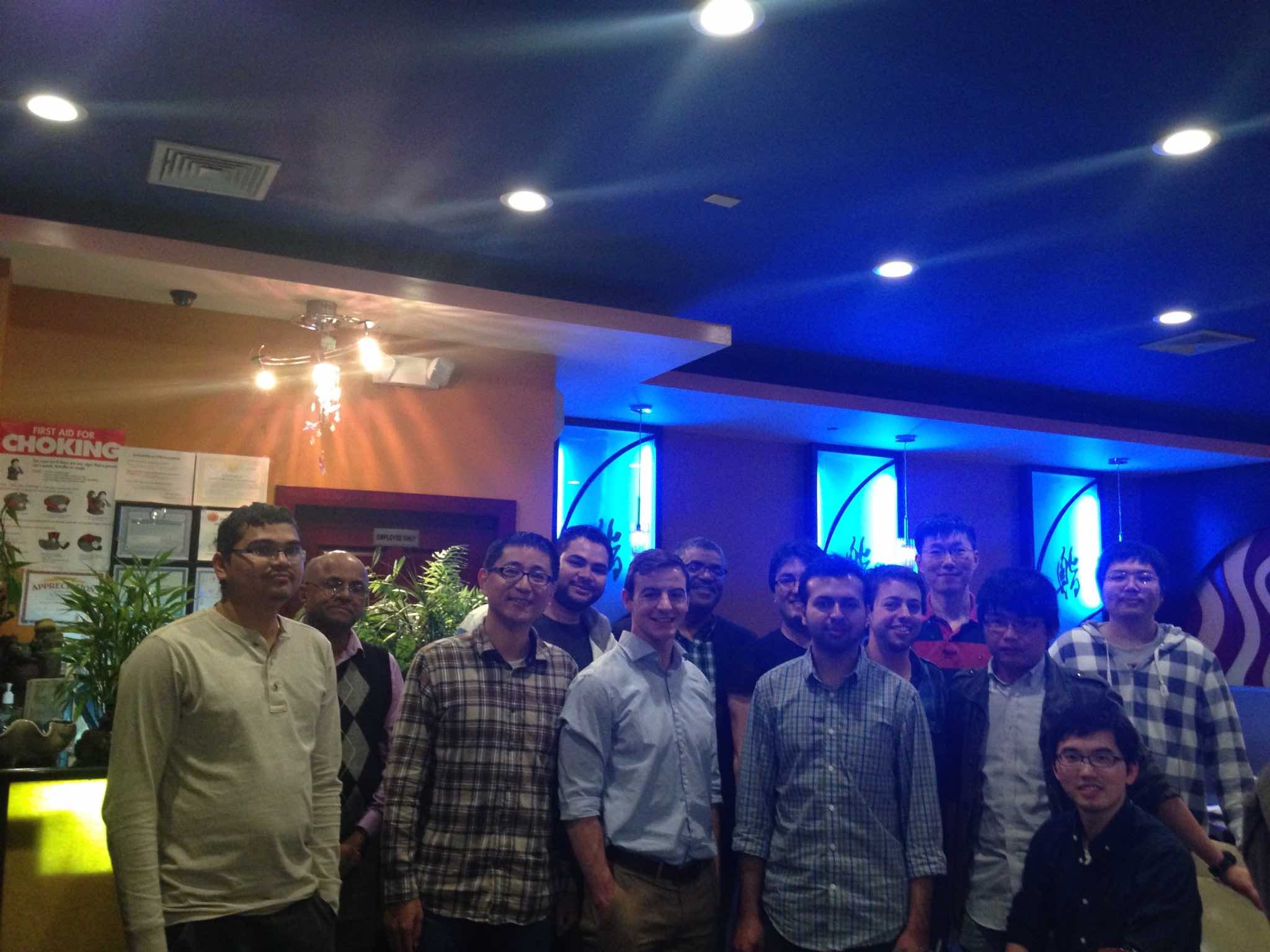
Jul 2016 | Party celebrating Sooraj and Thomas's graduations.
Older News
Oct 9, 2014
"Measurement of long-range pseudorapidity correlations and azimuthal harmonics in √sNN=5.02 TeV proton-lead collisions with the ATLAS detector" is published in PRC 1409.1792, a work led by Sooraj. This paper presented the most detailed measurement of harmonics v1-v5 using a recoil subtraction technique to remove the short-range correlations. For the first time the data show significant ridge at pT>10 GeV, possibly reflecting the existence of jet-medium interaction. The magnitudes of v2,v3 and v4 are surprisingly similar to Pb+Pb collisions with the same multiplicity (after removing the average geometry component), suggesting a similar mechanism for the observed harmonics in the two collision system.Oct 1, 2014
Three papers from Peng and Soumya have been published in the last two months (PhysRevC.90.024910 ,PhysRevC.90.034905 ,PhysRevC.90.034915). For the first time, the rapidity de-correlation of the harmonic flow is shown to be caused by the forward-backward fluctuations of participating nucleons and their transverse shape. Several method have been developed to measure such longitudinal flow flucuation and twist effects.
Aug 20, 2014
Thomas's work on W boson production in Pb+Pb collisions is submitted for publication (http://arxiv.org/abs/1408.4674). He is primarily responsible for the W->muon analysis. This paper addresses the benchmarking properties and modification to the PDF by measuring W bosons in Pb+Pb collisions at 2.76 TeV with the ATLAS detector.
May 31, 2014
In Quark Matter 2014, both Soumya's and Sooraj's results are highlighted. Link
Apr 16, 2014
Congratulation to Yi Gu's graduation! Our group member Yi Gu has successfully passed his PhD thesis defence. His work is focused on hadron flow measurements at PHENIX, particularly flow signals from correlation analysis and higher order flow harmonics studies. We had a dinner party after the meeting and here is the photo.
Mar 3, 2014
One of Soumya's thesis work " Measurement of event-plane correlations in √s_NN = 2.76 TeV lead–lead collisions with the ATLAS detector" has been submitted for publication! This paper show detailed centrality dependence of 8 two-plane and 6 three-plane correlators, the first measurement of this kind. It should provide strong constraint on non-linear mode-mixing effects in collective expansion of the Quark-Gluon matter created in lead-lead collisions. A job well done!
Nov 25, 2013
"Measurement of flow probability distribution in Pb+Pb collisions" is published in JHEP: JHEP11(2013)183. In this work led by Soumya, we obtained the first EbyE probability distribution of the elliptic flow v2, triangular flow v3 and quadrangular flow v4 in heavy ion collisions. These probability distributions p(vn) are obtained by unfolding the raw vn distributions with a data-driven response function that accounts for the smearing of the vn due to finite number of tracks in the detector acceptance. This is the first time unfolding method is successfully applied to the flow analysis. One key advantage of p(vn) distribution is that it allows direct and precise understanding on the role of the initial geometry and hydrodynamic responses. For example the measured p(v2) and p(v3) can be used to directly constrain the initial state eccentricity fluctuations p(ε2) and p(ε3). Details can be found at https://atlas.web.cern.ch/Atlas/GROUPS/PHYSICS/PAPERS/HION-2012-10/.
Aug 8, 2013
Soumya defended his thesis "Measurement of the azimuthal anisotropy for charged particle production in Pb+Pb collisions at √s_NN = 2.76 TeV and in p +Pb collisions at √s_NN = 5.02 TeV with the ATLAS detector at LHC".his work already results in 3 ATLAS publications. He is now a Research Associate in the Columbia University.
Dec 19, 2012
Observation of symmetric-ridge in proton - lead collisions: Studies of two-particle correlations in high-multiplicity proton–proton and proton–lead collisions at the LHC have shown a phenomenon frequently referred to as the "ridge". The ridge is a result of correlated production of particles at small relative-azimuthal angle (Δφ) over a wide range of relative pseudorapidity (Δη). Using data from the highly successful pilot proton–lead run on 12 September 2012, ATLAS has shown that the ridge has an identical twin resulting from correlated production of particles that are back-to-back in azimuth. The double-ridge structure extends over +/–5 units of Δη, and the strength of ridge increases with the transverse momentum and persists to at least 6 GeV in pT. The data analysis was carried out by soumya and Jiangyong.
Read more at: http://cerncourier.com/cws/article/cern/52346
Link to the paper and auxiliary plots.

